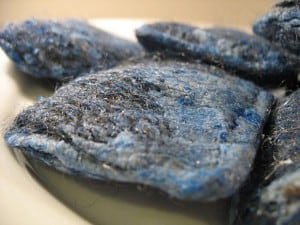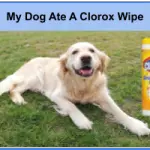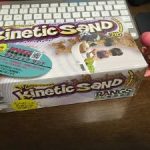
It sounds unlikely, but is it really?
You probably feed your dog all the right food. You buy your dog healthy treats. Occasionally you might give your dog some fresh meat. Chew toys. Bones. Gourmet something-something for its birthday.
With all these options you would think your dog couldn’t possibly go ahead and give you the what-do-I-do-nows by eating steel wool.
You are wrong.
What is steel wool?
Although steel wool can be used to polish wood or metal, we’re talking about bundles of very thin, flexible, abrasive steel wire used to scrub household cookware.
It’s made from low-carbon steel manufactured by pulling heavier steel wire through a machine that removes sharp wire shavings.
These fine strands of steel are then bunched together and turned into something you can use to scrape pots, pans, and baking sheets.
Maybe you’ve heard of S.O.S. pads, or Brillo pads.
S.O.S. pads are made from shaved steel wire and soap. The soap contains rust inhibitors, preservatives, biodegradable detergents, PH buffer, fragrance, and colour.
Brillo pads are made from steel wool, soap, fragrance, and colourant.
If these ingredients lists seem a bit vague it’s probably because these things aren’t meant to be eaten.
But nobody told our dogs that, did they.
Why would a dog eat steel wool?
Indeed.
Why would your dog eat steel wool covered in grease and charred chunks of delicious meat that smells like chicken, pork, and beef all cooked together…
What I’m saying is – and this may be hard to fathom – your steel wool might be delicious.
And left out on the counter.
But another common reason your dog might eat steel wool is something known as pica.
Pica is when your dog compulsively eats non-food items, like wood, cloth, paper, rocks, and… *gulp*… feces.
There are a couple reasons your dog might have pica.
- Behavioural reasons:
Your dog might be “stress eating.” Yes, dogs do it too, even if they aren’t stressed out from all the bills to pay, or a long day at the office.
If your dog is eating bedding or getting into the garbage it may be bored or anxious.
Exercise, mental stimulation, and a proper diet are the best ways to correct this behaviour. But strict behaviour modification training may be required in severe cases.
- Medical reasons:
Poor nutrition is a possibility. Your dog may not be getting what it needs if the quality of food is low.
But nutritional imbalances may also be caused by diseases of the thyroid, diabetes, anemia, gastrointestinal parasites, poisoning, or liver diseases. Any disease or condition that causes digestive disorders may be to blame.
Pica may also be a side effect of medication.
If you suspect your dog’s pica is a medical issue, see a vet!
Why is eating steel wool so dangerous for a dog?
Remember that steel wool pads are made from very thin, sharp filaments of steel all bundled together. These filaments begin to unravel as they’re chewed and as they pass through the stomach and intestine. The sharp strands of steel can cut into the intestinal wall.
It may only make things worse if your dog tries to vomit because the esophagus and stomach can get sliced during contractions.
And while the chemicals contained in Brillo and S.O.S. pads don’t appear to be toxic, they are at least caustic – that is, they may burn and damage your dog’s stomach.
Also. That steel wool may just get lodged somewhere and cause a blockage. It’s not a good day for your dog.
Can a dog’s stomach digest steel wool?
Nope.
A dog’s stomach acid is very strong, mind you.
Think car battery acid strong.
Think one hundred times the acid of a human stomach strong.
A dog’s stomach can stay at this acidity level for 5 hours while digesting. Meat and bone gets broken down into chyme within an hour. Pretty impressive.
And there are stories of dogs digesting – and excreting – some amazing things.
Still no match for steel though.
In other words, if your dog eats steel wool, there is a high likelihood it’s going to be dealing with a blockage.
What are the symptoms of a blockage in a dog?
If you suspect a blockage and notice any of these symptoms, it’s time to call the vet.
- Straining during bowel movements
- Inability to defecate
- Excessive drooling
- Refusing to lie down
- Vomiting
- Diarrhea
- Dehydration
- Abdominal pain
- Tarry stool
- Burping
- Remaining still
- Lethargy
- Loss of appetite
- Bloating
- Hunching or whining
Should you take your dog to the vet?
An unraveled steel wool pad causing a blockage may cause an intestinal rupture and even death. So, if your dog has eaten steel wool and is showing any of the above symptoms, it’s best to get expert advice and treatment.
Yes, take your dog to the vet.
The vet can explore different options for helping your dog.
For example, a vet can use a radiograph or ultrasound to check out the source of the blockage. A vet can also do an endoscopy – that’s where they put a camera down the dog’s throat to see what’s down there. This procedure is sometimes used to retrieve a lodged foreign object as well.
And only a vet should induce vomiting. Remember, vomiting may cause more damage in the case of a steel wool pad.
Your dog may need to be hospitalized and given IV fluids and other medicines to help pass the obstruction. And in severe cases the vet can anaesthetize your dog, make an incision in the abdomen, and remove the blockage.
After all this, your dog may be prescribed medication, and a regimen of fluids, rest, and bland dry food.
The vet is your friend.
Is there a way to treat a blockage at home?
If it isn’t steel wool, maybe.
Feeding your dog a bulky meal or dry food may get the digestive juices flowing and help soften the obstruction or pass it through the digestive system.
Just make sure your dog stays extra-hydrated.
Then look for evidence that the blockage has passed. You can do this by watching your dog when it defecates and then checking on your dog’s stool.
But again, if you notice any of the above symptoms of a blockage, home treatment may not be a wise option.
How to stop a dog from eating steel wool
Step 1: make sure your steel wool isn’t delicious and readily accessible.
But there are other options here.
Biodegradable sponges, for example.
Some biodegradable sponges come close to being as effective as a steel wool pad. Plus, they tend to be zero-waste, eco-friendly, and odour free. Some are plant-based.
Ingredients in biodegradable sponges include:
- Coconut fibre
- Wood cellulose, white cellulose, green cellulose
- Palm fibre
- Walnut
- Synthetic recycled fibre
These things aren’t half bad and could probably get the job done. They won’t have the effect of steel, to be sure. But your dog is less likely to need surgery if it eats one of them.
How can you clean all those dirty pots, pans, and oven trays without steel wool?
There are a few things you can try.
A brush. A regular sponge. A rag.
To avoid scrubbing an oven tray at all you can use baking sheets made of wax paper or tinfoil.
Either way, get that pot, pan, or tray soaked in hot, soapy water as soon as possible.
A solution made from baking soda, vinegar, and hot water may also work. Let it soak for 30-45 minutes and see how much easier it is to scrub off all that grime.
And don’t forget to try elbow grease.
Closing thoughts
It can be a bit scary to realize your dog has eaten a steel wool pad. But as you can see there are options. Lots of them. Options for dealing with it and options for preventing it.
Now you know what steel wool is, and why it can be dangerous for dogs. You know the symptoms of a blockage and how the vet can help.
And you probably understand why your dog would eat a steel wool pad, crazy as it may seem.
Brillo. S.O.S. It doesn’t matter to a dog. If it smells enticing and is sprinkled with crispy morsels of meaty goodness… It’s dangerously delicious.





